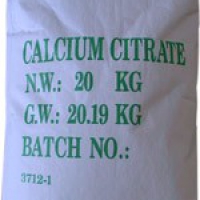
Product related instructions:
1, the chemical name: tricalcium citrate, alias: calcium citrate
2, the molecular formula: Ca3 (C6H5O7) 2.4H2O
3, the molecular weight: 570.50
4. Properties: white powder, odorless, slightly hygroscopic, extremely difficult to dissolve in water, (0.095g/100ml, 25°C), almost insoluble in ethanol (0.0089g/100ml, 25°C), heating water to 100 At °C, the water is gradually lost, and the water is completely lost at 120 °C.
5, Quality Standard: Index Name USP-23 Appearance White Crystal Powder Content, % 97.5-100.5 Arsenic (As), ≤% 0.0003 Fluoride, ≤% 0.003 Heavy Metal (in Pb), ≤% 0.002 Loss on Drying, % 10.0- 13.3 Acid insoluble matter, ≤% 0.2
6, use: chelating agent; buffer; tissue coagulant; calcium fortifier, emulsified salt. According to GB1980-94, it is used for beans and their products, beverages, 8-16/kg. According to FAOWHO (1984), the use and limit are: low-concentration concentrated milk, sweetened condensed milk, cream and other single use 2g/kg, combined with other stabilizers 3g/kg (as anhydrous); milk powder, cream powder 5g/kg; melted cheese made 40g/kg; jam and jelly; canned tomato, cold drink, caseinate, according to GMP as a fortifier, the theoretical calcium content of this product is 21.07%, can be used for flour, cakes, Japanese fermented bean paste, etc., Japan's prescribed limit is 1%.
7, packaging: lined with polyethylene plastic bags, jacket composite plastic woven bags, each bag net weight 25kg.
8. Storage and transportation: This product should be stored in a dry and ventilated warehouse. It should be lightly handled during loading and unloading to prevent damage to the packaging, prevent moisture, and store separately from toxic substances.
|


